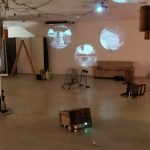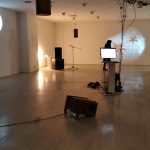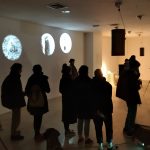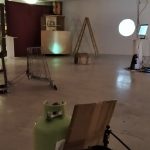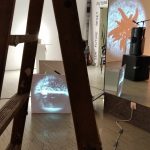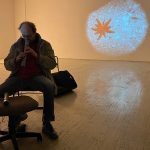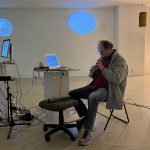Nemi filmi | The Silent Movies (Francisco Tomsich – Borut Savski)
video-zvočna generativna narativna instalacija
Posvečeno Simonu and Boštjanu
Cirkulacija 2
Podhod Ajdovščina, Ljubljana
22. marec – 6. april 2023
Otvoritev :: Sreda 22.3.2023, 20:00 ::: Performance: The Benshi Project: Summer Songs
Summer Songs, drugi projekt dua The Silent Movies, je umetniško okolje, sestavljeno iz vrste virov vizualnih, zvočnih in verbalnih informacij, ki so med seboj odvisni. Deluje kot neskončen koncert, na katerem video instalacija, sestavljena iz serije nedavnih nemih filmov Francisca Tomsicha, zagotavlja grobo gradivo, rdeče niti in digitalne podatke zvočnemu ekosistemu, razvitemu z izvirno programsko opremo in materializiranemu s posebej izdelanimi zvočnimi viri (-> vibracijski zvočniki) Boruta Savskega.
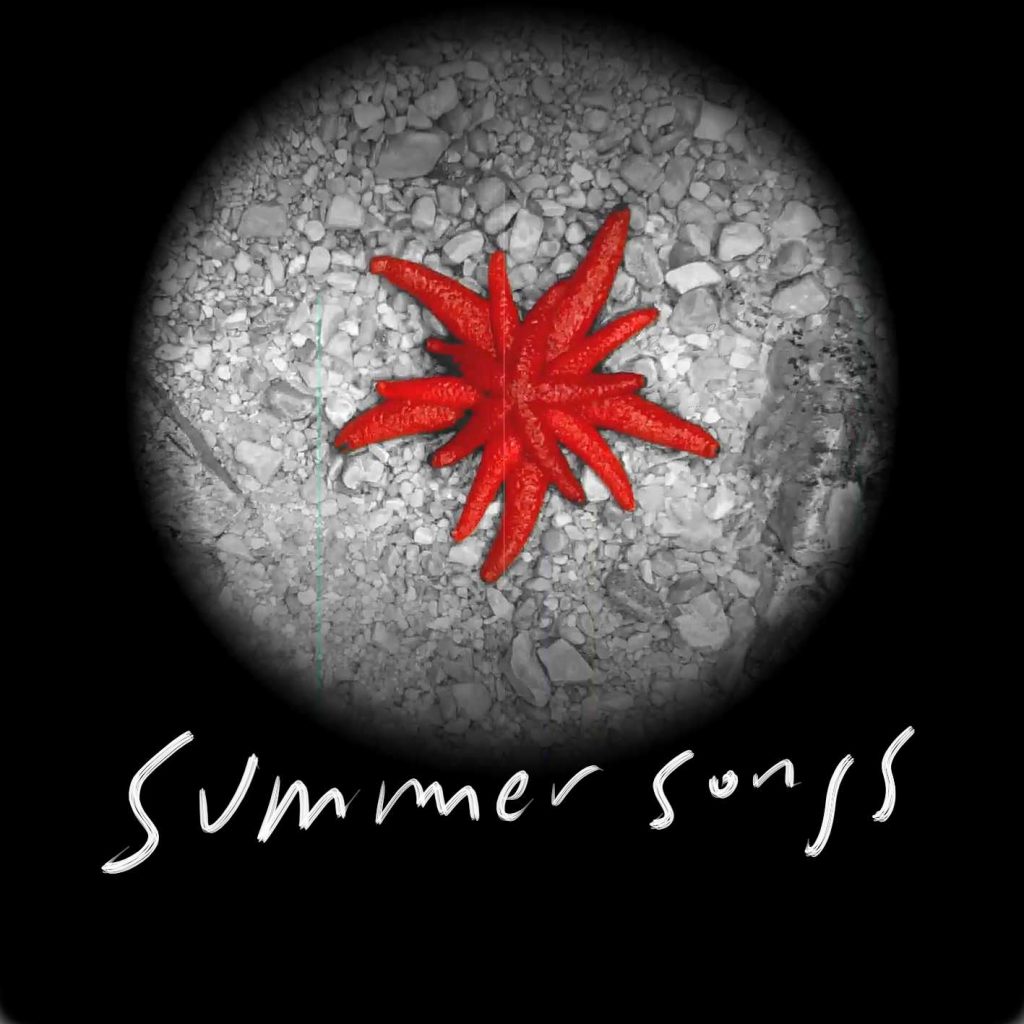
Francisco Tomsich:
Serija nemih, kratkih, pogosto meditativnih, večinoma enobarvnih video instalacij Silent Works je sestavljena iz umetnikovih videodnevnikov. Zato ta dela izkazujejo močan dokumentarni vidik, okrepljen z raziskavami in naborom referenc, it katerih črpajo, vendar hkrati dajejo prednost nekakšnemu prividu/ uvidu (prikazni), to je razodetju ali satoriju, ki izhaja iz kontemplacije in včasih dolgočasja – kot nagrada za določen impulz, ki me je napotil k snemanju.
Dela, vključena v to razstavo, so:
– Reader’s Digest o popularni zgodovini Jugoslavije
– Hrvaška poletna pesem
– Obramba
– Skopski triptih
– The Futures
– Gabove sanje
Posnetek vključeni v to novo serijo Silent Works, so nastajali več let na različnih lokacijah v Sloveniji, Hrvaški, Bosni in Severni Makedoniji. Vsi skupaj pripovedujejo, dobesedno ali alegorično, zgodbo o pokvarjenih poletjih. Ne brez veselja in ironije pa jih prečkajo različni modeli katastrof. S formalnega vidika so ta nova nema dela sestavljena na način glasbenih analogij (pri video montaži), da bi dosegli značilnosti različnih struktur pesmi. Napajajo jih tudi moji zadnji dve leti intenzivnega študija zgodovine japonskega filma, to je področja dodatnih referenc, kar je postavilo temelje za dodaten pristop k nememu značaju teh del: projekt Benshi, ki se ukvarja z jezikovnimi in narativnimi vidiki in je artikuliran v performativnem smislu.
Borut Savski – Distribuirano telo:
Video-zvočni sistem je zgrajen na način antropomorfnega telesa, kar pomeni, da ima ude, osnovno telo in živčno-cerebralni centralni del, kamor sodi tudi vizualno zaznavanje video virov. Telo z vsemi temi organi vstopa v prostor na način naprave, kar pomeni, da je periferno živčevje ožičenje.
Vizualni del programja poganja tri osrednje video vire, iz katerih sproti zajema spremembe v sliki. Te so stvar programske knjižnice OpenCV (computer vision) v programskem okolju Python. Velikost in pozicija bistvene spremembe v vsaki sliki se spremeni v simbolični krog s koordinatami njegove pozicije in pošlje v zvočni del programja, zgrajenega v okolju Puredata. To omogoča tudi delovanje v lokalni mreži, tako da lahko na zvok vplivajo še dodatni video viri.
Osnova cerebralnega dela poteka na ravni zvoka: tu potekajo vse odločitve, ki jih lahko glasbeno imenujemo interpretacija. Vsi približki in odmiki od glasbene estetike se zgodijo kot posledica vgrajenih odločitev. V veliki meri so odločitve lahko v veliki meri poljubne – stohastične. Potekajo po principu treh skupin gostote zvoka: razredčeno/ umirjeno, srednje in zgoščeno/ intenzivno, kar se tiče predvsem časovne komponente, ki na ta način proizvede tudi vedno različne obsežnejše kose zvočnih ugodij, katerih vrstni red in gostota nista predvidljiva. Oblikovanje tega zvočnega algoritma bo potekalo v vseh dneh postavitve/ instalacije.
Viri zvoka so zvočni koščki/ sampli, ki se bolj ali manj nanašajo na posamezne slikovne podobe iz kazerih se podatkovno napajajo. Štirje izhodni zvočni kanali lahko delujejo ločeno, ali pa se v večji ali manjši meri prelivajo med seboj – po prostoru.
Zanimiva je tudi ideja, da se kot zvočni viri uporabi razmeroma nov tip zvočnika, ki je vibracijski zvočnik. Njegova značilnost je, da se zvok ustvarja na način prenosa vibracij na poljuben material, ki ima mnogo večje dimenzije kot je vibracijski vzvod zvočnika. Naša odločitev je bila, da posebno lahko leseno ploščo ukrivimo v tulec in stem dosežemo enakomerno sevanje zvoka na vse prečne strani vertikale tulca. To se imenuje omnidirekcijski zvočnik. Leseni tulec smo spodaj in zgoraj zaprli, da ustvarimo dodatni resonančni prostor, ki ojača nižje srednje frekvence. Dosedanji rezultati preverjanja zvoka so specifični, mestoma pa celo briljantni.
Distribuirano telo je sicer naslov instalacije/ zvočnega dogodka, ki ga je Borut Savski izvedel decembra 2005 v Mali galeriji (Moderna galerija) v Ljubljani. v kateri je prvič jasno opisal antropomorfno strukturo interaktivno-generativnega telesa za proizvodnjo zvoka. Njegova prva zvočno-prostorska instalacija Zvočni Biotop (1999; Galerija Kapelica Ljubljana) – je že vsebovala takšen način izvedbe.
Metafizični dodatek: Metafora cerebralnega
V povezavi s projektom Summer Songs, se lotimo ubesedovanja principov sestavljanja soprisotnih raznolikosti v celoto. Takoj je jasno, da gre za klasično dihotomijo vizualnega/ videnega (nujno fokusiranega, da bi videli – zato parcialnega) in zvočnega / auralnega (v prostoru veliko bolj vseprisotnega in s tem povezovalnega). Ob ta dva tipa pripovedi dodamo še verbalno pripoved, ki na nek način lahko vstopi v zaznavo/ spoznavo kot kombinacija prvih dveh.
Pogled ima naravo fokusiranja – odmišljenja okoliških nepomembnosti na račun osredotočenosti v detajl. Periferno vidno polje je informacijsko omejeno – služi zgolj kot dodatni varnostni mehanizem. Hkraten pogled na po prostoru razmetane vizualne detajle ni možen. Celovit pogled je možen le na način pomnjenja videnih detajlov – in interpretacijo /spoznavo celote, ki pa obstaja le na ravni občutka / zaznave. Posamezne video zgodbe so gibljive slike, ki so vsaka zase koherentne – vsebinsko in slikovno samostojno povedne. Nekakšni informacijski mikroskupki – miniature. Spomini so prav tako pogosto kratke vizualne podobe, ki prek bolj ali manj stabilnih sinaptičnih povezav nosijo povedno informacijo. Ali so v poved povezane besede (smiselne povedi) prav tako slike? V bolj prostem asociativnem procesu (npr. v spanju) se lahko slike, povedi in em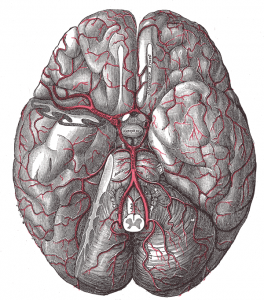 ocionalni skupki (-> informacije) spajajo v daljše verige. Kljub občutku povezanosti lahko hitro uvidimo, da gre za lepljenko posameznih fragmentov. Šele razmislek v možganskem korteksu lahko sestavi občutek vzporedja/ sobivanja posameznih pogledov.
ocionalni skupki (-> informacije) spajajo v daljše verige. Kljub občutku povezanosti lahko hitro uvidimo, da gre za lepljenko posameznih fragmentov. Šele razmislek v možganskem korteksu lahko sestavi občutek vzporedja/ sobivanja posameznih pogledov.
V primeru projekta Summer Songs imamo na voljo še en informacijski kanal, ki je tesno povezan s hkratno neulovljivo pripovedjo večjega števila slikovno povednih podob. To je zvok. Zvok nastaja neposredno iz sprememb v video sliki, zato lahko trdimo, da v največji meri sledi naraciji vsakega posameznega soprisotnega vizualnega fragmenta. Korespondenca je torej tehnično samoumevna. Zvok nima zelo konkretne povedi – ostaja abstrakten. V vlogi spremljevalca pripovedi deluje emocionalno. Da bi se ognili dobesednosti in približali muzikalnosti, uporabimo interpretacijo, kar v glavnem pomeni redukcijo podatkov in večjo težo na glasbeni interpretaciji – dodani arpeggii, ritmiziranje in podobno. Asinhrone soprisotne pripovedi imamo željo melodično in ritmično občasno uskladiti – kar pomeni v neki točki soočiti/ primerjati zvočne tokove. To že pomeni na kortikularni način vzpostaviti “nadzornika”, ki urgira na licu mesta in v danem trenutku – kar nakaže zametke “zavedanja celote”. To pa se lahko na dostojen način zgodi šele v cerebrumu obiskovalca. Na filmski način z zvokom stilsko (emocionalno) podpremo sicer fragmentirano (a koherentno) slikovno dogajanje.
Kot posebni pripovedni moment se lahko kot tretji vzpostavi pripovedovalec – govorjena beseda. Na način japonskega pripovedovalca benshi (*) je besedna pripoved lahko verbalna interpretacija vizualno fragmentiranega dogajanja. Besede usmerjajo pozornost opazovalcev od enega fragmenta na drugega. Na ta način besede sestavijo smiselno zaporedje slik. Seveda je podobno kot s prosto asociacijo ta redosled lahko vsakokrat različen – in pomensko spremenljiv. Ali celo zavajajoč. Za tovrstno pripoved se zdi, da vstopa v korteks na način vizualnega spoznanja, čeprav je zaznava zvočna. Za razumevanje je potrebno fokusiranje – a ne pogleda.
* Benshi so (bili) japonski igralci/ pripovedovalci, ki so z živo besedo spremljali neme filme (japonske in zahodnjaške).
Produkcija: Cirkulacija 2 + Boja
Sofinanciranje: Mestna občina Ljubljana
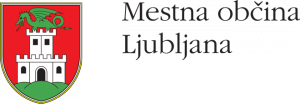
 my RSS
my RSS
